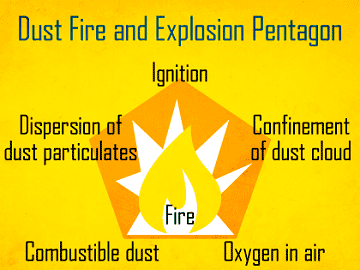- Home
- Loss Control
- Loss Control Insights
- 3 Ways to Minimize Combustible Dust Hazards
Dust is the byproduct from work in many industries, and it’s found nearly everywhere: drifting from materials such as agricultural products, chemicals, plastic, metals and more; during processes ranging from grinding, cutting and blasting. The truth is, where there is dust, there is also a potential for fire or explosions.
Knowing the basics of dust and how it can lead to combustion is crucial for controlling the dangers you may be facing. Fires and explosions occur when there is fuel (that’s the dust), along with oxygen (it’s all around us) and ignition (this can be caused by a spark, an open flame or by heat). You need to know how to stay in control of these elements to reduce the chances of an unwanted fire. While you can’t easily control oxygen, you can take steps to avoid the fuel and ignition sources.
1. Manage dust
A good dust collection system located outside of the building can pick up small particles. It should be equipped with both spark detection and an explosion suppression system. Since no collection system can remove 100 percent of the dust, good housekeeping practices are important. Cleaning needs to be a regular part of the work schedule, and should include checking areas where dust may hide from view, such as on elevated horizontal surfaces and inside electrical enclosures that aren’t dust-proof. Use only approved cleaning equipment, such as high-efficiency particulate air (HEPA) vacuum cleaners rated for combustible dusts. Avoid using compressed air as a cleaning method.
2. Control ignition sources
If your facility has equipment that gets hot when it’s running, vehicles moving in and out of your work areas or open flames, you have an ignition source. Be aware of less obvious sources of ignition such as bearings that may overheat if not maintained properly, accidental electrical arcing or an electrostatic discharge. It’s important to have written, assigned procedures for regularly checking and then immediately fixing equipment that may become a problem. You can help control ignition dangers by ensuring that all equipment and machinery is bonded and grounded, and by implementing both an ignition control plan and a hot work permit program. The EMC Hot Work Program template can help you develop a plan including both ignition control and hot work procedures.
3. Train your workforce
Workplace explosions make major news, often injuring and killing many workers and destroying entire buildings in a single incident. To prevent deadly situations, everyone in your workplace must work to prevent dust buildup. Every on-site worker needs to know the explosion hazards of combustible dust and their part in preventing problems.
Recommendations include:
- Inspect your workplace regularly for hazards, including dust accumulations and ignition sources
- Maintain cleaning equipment and ensure and that workers are trained on and follow correct cleanup procedures
- Incorporate damage-control methods into your workplace, including fire suppression and explosion protection systems
- Develop an emergency action plan and train all employees on the plan in case of emergency
- Keep emergency exit routes clear at all times
Assistance Available
Contact your EMC loss control representative to help you manage dust, control ignition sources and develop training programs for your employees. There are many other sources of information to help develop safe dust management and cleaning practices, including National Fire Protection Association (NFPA) and OSHA, as well as vendors who can provide professional assistance in setting up collection and cleaning systems.Get in touch
Need help? We’re here for you! Whether you have questions or need personalized assistance, your local office is ready to support you.
Loss Control Insights
Stay informed with the latest news and receive actionable safety tips, all carefully curated by our team of experts.
